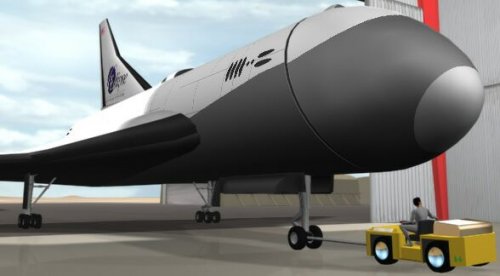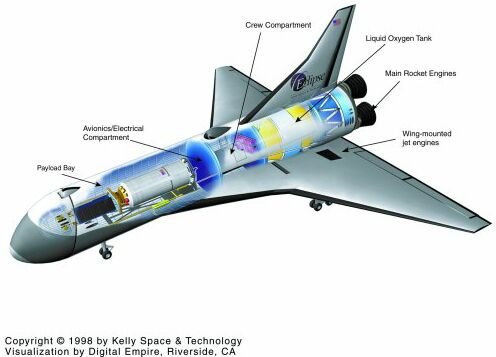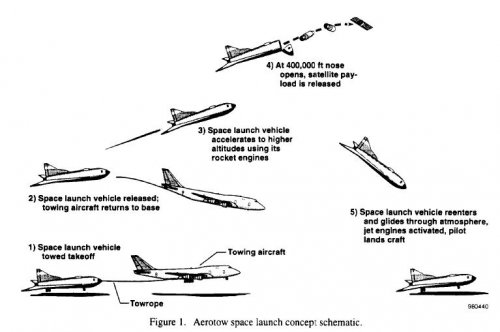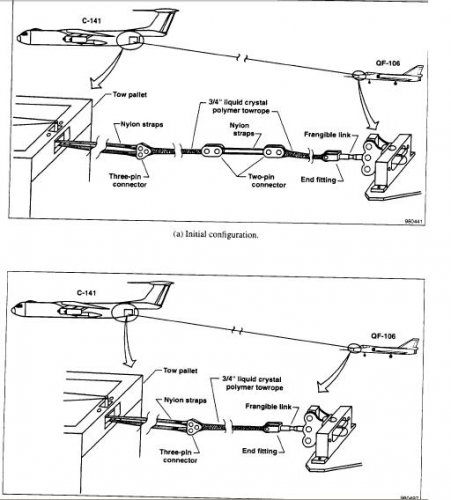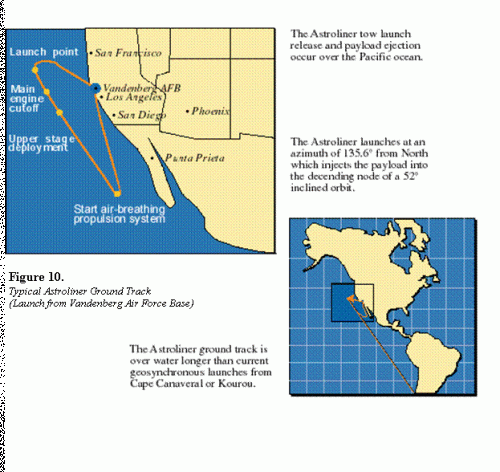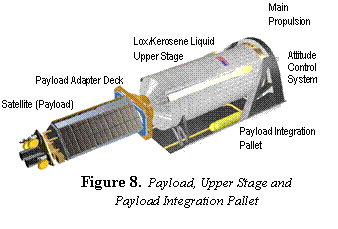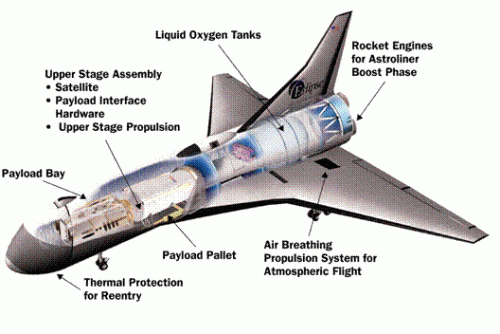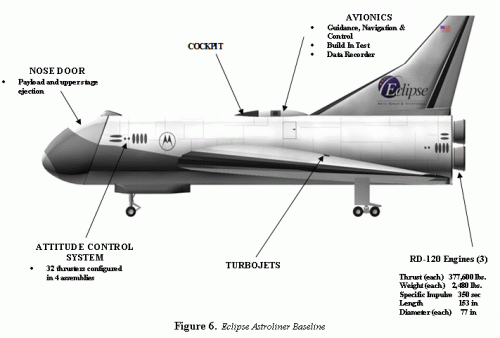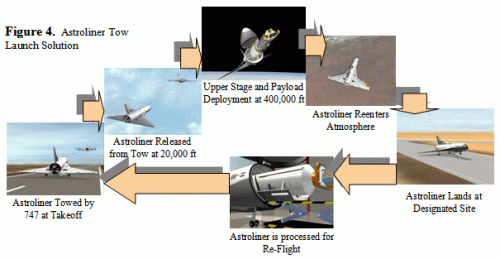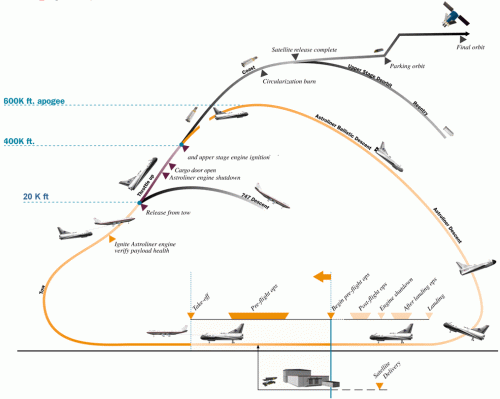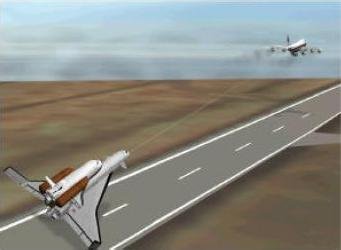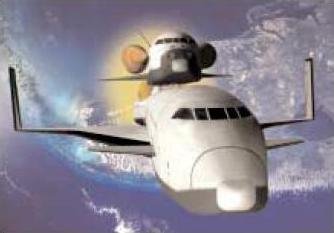You are using an out of date browser. It may not display this or other websites correctly.
You should upgrade or use an alternative browser.
You should upgrade or use an alternative browser.
Aerotow space launch concept
- Thread starter hesham
- Start date
http://www.nasa.gov/centers/dryden/history/pastprojects/Eclipse/index.html
Links to pics and movies at the above address.NASA Dryden Flight Research Center supported and hosted a Kelly Space and Technology, Inc., (KST)/USAF project, known as Eclipse, which demonstrated a reusable tow launch vehicle concept. The goal of the project was to successfully tow in flight a modified QF-106 delta-wing aircraft with an Air Force C-141A transport-type aircraft.
compton_effect
ACCESS: Confidential
- Joined
- 13 June 2007
- Messages
- 77
- Reaction score
- 38
Hmm. It was in development at the same time as Roton. It looks like the company is still in business, just diversified in to other markets. It still looks like quite a good launch method to me.
http://www.kellyspace.com/index.php/business/rlvt2/
http://www.kellyspace.com/index.php/business/rlvt2/
Attachments
FutureSpaceTourist
ACCESS: Top Secret
- Joined
- 10 March 2010
- Messages
- 590
- Reaction score
- 34
Dragon029 said:I wonder why the tow aircraft only goes to 20,000ft? Double that would seem more efficient unless there's just plain too much weight being dragged behind to get to those altitudes.
I assume it's down to the limitations of the tow aircraft. From what I've read one key claimed benefit of the towing approach is the ability to use an existing aircraft to do the towing (at least without major modifications) so there aren't the costs involved in developing a new aircraft. Part of the argument also being that unless there are high flight rates it isn't economic to have a specialist tow aircraft sitting around much of the time under-utilised.
Of course some air launch concepts take a rather different approach! For example, WhiteKnightTwo and SpaceShipTwo. I guess Virgin is banking on space tourism flights, and maybe subsequently nano-sat launches, being frequent enough that the cost of a specialist carrier aircraft is recouped. Of course they also get a higher launch altitude for the spaceship (about 45,000ft) but I don't know how significant that difference is.
FutureSpaceTourist
ACCESS: Top Secret
- Joined
- 10 March 2010
- Messages
- 590
- Reaction score
- 34
Kelly Space animation of the Eclipse Astroliner concept (note the hinged Astroliner nose for ease of loading):
http://www.youtube.com/watch?v=xlLPuzjNFu0
http://www.youtube.com/watch?v=xlLPuzjNFu0
FutureSpaceTourist
ACCESS: Top Secret
- Joined
- 10 March 2010
- Messages
- 590
- Reaction score
- 34
Re: Eclipse space transport
Much more information about Eclipse can be found in the aerotow space launch thread: http://www.secretprojects.co.uk/forum/index.php/topic,6879.msg58793.html#msg58793.
Much more information about Eclipse can be found in the aerotow space launch thread: http://www.secretprojects.co.uk/forum/index.php/topic,6879.msg58793.html#msg58793.
The tow-launch concept allows you to offload the mass of your first-stage engines and fuel to the towing aircraft, but the wings must be sized to support the weight of the launcher during cruise at 20Kft, and the landing gear must be sized to support the fully-loaded weight of the launcher. 20kft is about half the altitude of captive-carry concepts like Pegasus. I wonder how much delta-V must be expended at the lower altitudes (where nozzle efficiency is reduced and drag is higher) just to get to the Pegasus ignition altitude.
Picking your launch altitude is a trade-off between the energy you get from height and the additional dry weight needed to get there. The lower you are the less wing you need to hold up the glider.
We had a similar issue at Pioneer, see page 11 here:
http://www.kelthaven.org/papers/AAS99-129slides.pdf
We had a similar issue at Pioneer, see page 11 here:
http://www.kelthaven.org/papers/AAS99-129slides.pdf
FutureSpaceTourist
ACCESS: Top Secret
- Joined
- 10 March 2010
- Messages
- 590
- Reaction score
- 34
Here's some information on a TSTO (not including the towing aircraft) Astroliner. Taken from the FAA 2001 RLV report:
[quote author=FAA 2001 RLV report]
Slowed development of the NGSO satellite market has prompted a change in Kelly Space and Technology efforts to develop space transportation capabilities. Last year, Kelly planned to design and develop the Astroliner vehicle for launch in 2002. The company is now focused on development of “Second Generation” RLV capabilities that will serve sub-orbital, NGSO, geostationary orbit and ISS customers.
Kelly’s piloted Second Generation RLV system will be based on its patented horizontal takeoff and landing, tow-launch technique and is designed to carry humans and cargoes to and from destinations off the Earth. The two-stage-to-orbit (TSTO) system will be towed to its various airborne launch sites using a modified Boeing 747 aircraft. The RLV’s on-board turbine engines will supplement the thrust of the tow aircraft during the initial ascent. The RLV system will be released at the launch site and, using its rocket engines, ascend to stage separation. The second stage system for the specific mission will proceed to orbit. The first stage will return to its planned landing site, using its turbine engines again for powered landing on conventional runways.
Kelly’s RLV system includes a number of different upper stage vehicles, including cargo-only delivery/return vehicles, and a seven person Crew Transfer Vehicle (CTV). The system is designed to serve all current and future customers anticipated through 2030, including both government and private citizen space travelers. The system design will readily accommodate the use of customer-supplied orbit transfer stages in conjunction with their satellites or other cargoes. The CTV incorporates its own propulsion system for orbit-deorbit and orbital maneuvering needs.
[/quote]
[quote author=FAA 2001 RLV report]
Slowed development of the NGSO satellite market has prompted a change in Kelly Space and Technology efforts to develop space transportation capabilities. Last year, Kelly planned to design and develop the Astroliner vehicle for launch in 2002. The company is now focused on development of “Second Generation” RLV capabilities that will serve sub-orbital, NGSO, geostationary orbit and ISS customers.
Kelly’s piloted Second Generation RLV system will be based on its patented horizontal takeoff and landing, tow-launch technique and is designed to carry humans and cargoes to and from destinations off the Earth. The two-stage-to-orbit (TSTO) system will be towed to its various airborne launch sites using a modified Boeing 747 aircraft. The RLV’s on-board turbine engines will supplement the thrust of the tow aircraft during the initial ascent. The RLV system will be released at the launch site and, using its rocket engines, ascend to stage separation. The second stage system for the specific mission will proceed to orbit. The first stage will return to its planned landing site, using its turbine engines again for powered landing on conventional runways.
Kelly’s RLV system includes a number of different upper stage vehicles, including cargo-only delivery/return vehicles, and a seven person Crew Transfer Vehicle (CTV). The system is designed to serve all current and future customers anticipated through 2030, including both government and private citizen space travelers. The system design will readily accommodate the use of customer-supplied orbit transfer stages in conjunction with their satellites or other cargoes. The CTV incorporates its own propulsion system for orbit-deorbit and orbital maneuvering needs.
[/quote]
Attachments
- Joined
- 1 November 2009
- Messages
- 638
- Reaction score
- 428
One little nit to pick. Shouldn't that concept be called Three Stage to Orbit? The 747 is part of the launch process so shouldn't it be counted as a stage?
FutureSpaceTourist
ACCESS: Top Secret
- Joined
- 10 March 2010
- Messages
- 590
- Reaction score
- 34
The Artist said:Shouldn't that concept be called Three Stage to Orbit? The 747 is part of the launch process so shouldn't it be counted as a stage?
Yes, I agree. Kelly Space themselves have I think been a bit inconsistent at times (assuming they provided the material for the FAA report). I guess they call it a TSTO, excluding 747, perhaps because it sounds better(?!) or to emphasise that those two are the 'bespoke' stages? However, the summary box in the same FAA report section says: "Number of stages: 3-4 (including towing aircraft)" [Maybe TSTO means three-stages-to-orbit in this case ;D]

